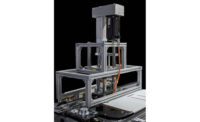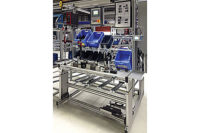Smart cameras are a standard vision-inspection tool for manufacturers in the auto industry, whether they’re a lower tier supplier or one of the Big 3. Continental AG, the global Tier 1 automotive supplier, uses cameras in many plants to ensure quality and traceability of its various products: tires, brake systems, powertrain and chassis components, tachographs and electronic assemblies.
One Continental factory in the Czech Republic specializes in electronic assemblies. As in the United States, the auto industry there mandates each part of an assembly be labeled with identifying data so the part can be easily tracked throughout the supply chain.
The label contains a logo, description and code 39 bar code. For many years, Continental applied the label with a pneumatic applicator, and then used a stationary linear scanner to read the serial number encoded in the bar code to verify the serial number matched the part.
Recently, however, Volvo Auto Czech demanded Continental also begin verifying the presence, position, orientation and printed-content appearance of each label. To meet this challenge, the company replaced the scanner with a Vision MINI smart camera that performs all four functions. Manual inspection was not a viable option because of its high cost and likelihood of errors.
Bar code printing and scanning integrator Bartech s.r.o. recommended Continental select the Vision MINI, made by Microscan Systems Inc., because it communicates with a PLC via an RS-232 serial connection. This capability enabled Continental to easily integrate the camera into the existing assembly line without extensive reprogramming.
Equally important, the camera is small (26 by 46 by 54 millimeters) and light enough (2 ounces) to fit within the limited space of the line’s X-Y gantry robot. The camera also comes with a library of vision tools.
After camera selection, Bartech established the application’s software settings, hardware specifications and lighting considerations. Although the smart camera has integrated lighting, an external lighting source (Nerlite HI-BRITE 45) was required to further enhance contrast on the monochromatic parts.
The camera’s communication protocols with the PLC are set up to emulate the scanner. After a label is printed, the PLC sends a serial trigger to the camera, which reads the bar code and sends the data back to the PLC over the RS-232 connection.
Simultaneously, a separate command triggers the camera to locate the label on the part, verifying its presence, position and orientation. The camera’s pattern match tool ensures the correct appearance of printed content. Setting thresholds for the camera to detect unacceptable parts required comprehensive testing with correct and intentionally flawed labels.
Since its installation, the smart camera-based system has eliminated the presence of skewed or misplaced labels, printing errors and missing labels. Besides saving money for Continental, the system ensures that Volvo Auto Czech always receives the right part.
For more information on miniature smart cameras, call 800-762-1149 or visit www.microscan.com.




